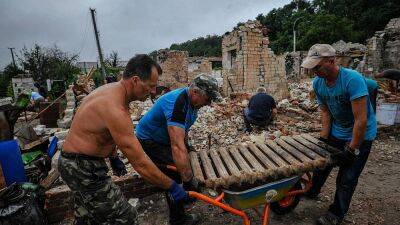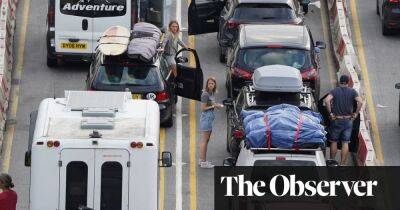Postcards from a 40C future: what extreme heat means for the UK
With 10 major incidents declared by fire services across the UK on Tuesday, infrastructure failures, and excess deaths over the heatwave estimated at about 1,000, the immediate impact of record 40C temperatures was severe enough in its own right. But for many people, the most troubling thing about the heatwave was the 48-hour preview it provided of what’s coming down the line.
By 2050, 35C summers will be commonplace in the south of England, and 40C days will become far more frequent. But while many features of that future are reason for alarm, there are also glimpses of a better alternative if the political will can be summoned to fight for it.
Here are three possible aspects of a 40C future in the UK that reflect the worst of what the country has seen this week – as well as how things might play out differently.
Since Monday, airport runways have melted. Two UK rail mainlines have closed, and others have run much slower than normal. Roads have buckled, orturned into “black goo”. Congestion has fallen as many people stay at home, but those working jobs that require them to travel have had to navigate a creaking and overheated public transport network.
By 2050, even if the worst case scenarios of climate change are avoided, regular long hot summers will place those same networks under acute pressure. It will take “decades” to update rail infrastructure designed to function below 35C, or to replace tarmac on roads that struggles at extreme temperatures, transport secretary Grant Shapps said on Tuesday. When multiplied by the remote-working trend that the pandemic accelerated, that suggests the emergence of an even more pronounced division between those who can stay at home – and those with hands-on, mostly low-paid jobs who
Read more on theguardian.com




![Shiba Inu [SHIB] climbs >4%; flouts $200 million crypto market liquidation onslaught - ambcrypto.com - city Santiment](https://finance-news.co/storage/thumbs_400/img/2022/8/21/37915_vrxm5.jpg)




![Curve [CRV] investors neck-deep in confusion should examine this data because… - ambcrypto.com - city Santiment](https://finance-news.co/storage/thumbs_400/img/2022/8/21/37910_yf5h.jpg)
![Sandbox [SAND]: Before traders wash off this metaverse token, they should know - ambcrypto.com - city Santiment - city Sandbox](https://finance-news.co/storage/thumbs_400/img/2022/8/20/37909_lbo.jpg)












